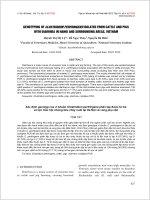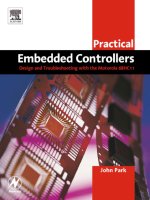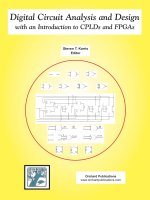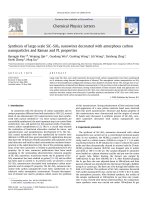Embedded SoPC design with nios II processor and VHDL examples
Bạn đang xem bản rút gọn của tài liệu. Xem và tải ngay bản đầy đủ của tài liệu tại đây (31.1 MB, 720 trang )
EMBEDDED SOPC DESIGN
WITH NIOS II PROCESSOR
AND VHDL EXAMPLES
EMBEDDED SOPC DESIGN
WITH NIOS II PROCESSOR
AND VHDL EXAMPLES
Pong P. Chu
Cleveland State University
) WILEY
A JOHN WILEY & SONS, INC., PUBLICATION
Copyright ©
2011
by John Wiley & Sons, Inc. All rights reserved
Published by John Wiley & Sons, Inc., Hoboken, New Jersey
Published simultaneously in Canada
No part of this publication may be reproduced, stored in a retrieval system, or transmitted in any form or by any means,
electronic, mechanical, photocopying, recording, scanning, or otherwise, except as permitted under Section 107 or 108 of
the 1976 United States Copyright Act, without either the prior written permission of the Publisher, or authorization through
payment of the appropriate per-copy fee to the Copyright Clearance Center, Inc., 222 Rosewood Drive, Danvers, MA
01923,
(978) 750-8400, fax (978) 750-4470, or on the web at www.copyright.com. Requests to the Publisher for permission
should be addressed to the Permissions Department, John Wiley & Sons, Inc., 111 River Street, Hoboken, NJ 07030, (201)
748-6011,
fax (201) 748-6008, or online at
Limit of Liability/Disclaimer of
Warranty:
While the publisher and author have used their best efforts in preparing this
book, they make no representations or warranties with respect to the accuracy or completeness of the contents of this book
and specifically disclaim any implied warranties of merchantability or fitness for a particular purpose. No warranty may be
created or extended by sales representatives or written sales materials. The advice and strategies contained herein may not
be suitable for your situation. You should consult with a professional where appropriate. Neither the publisher nor author
shall be liable for any loss of profit or any other commercial damages, including but not limited to special, incidental,
consequential, or other damages.
For general information on our other products and services or for technical support, please contact our Customer Care
Department within the United States at (800) 762-2974, outside the United States at (317) 572-3993 or fax (317) 572-4002.
Wiley also publishes its books in a variety of electronic formats. Some content that appears in print may not be available in
electronic formats. For more information about Wiley products, visit our web site at www.wiley.com.
Library of Congress Cataloging-in-Publication Data is available.
ISBN 978-1-118-00888-1
Printed in the United States of America.
oBook ISBN: 978-1-118-14653-8
ePDF ISBN: 978-1-118-14650-7
10 987654321
To my mother, Chi-Te, my wife, Lee, and my
daughter, Patricia
CONTENTS
Preface
Acknowledgments
1 Overview of Embedded System
1.1
1.2
1.3
1.4
1.5
Introduction
1.1.1 Definition of an embedded system
1.1.2 Example systems
System design requirements
Embedded SoPC systems
1.3.1 Basic development flow
Book organization
Bibliographic notes
XXV
xxxi
1
1
2
3
4
5
PART I BASIC DIGITAL CIRCUITS DEVELOPMENT
2 Gate-level Combinational Circuit 11
2.1 Overview of VHDL 11
2.2 General description 12
2.2.1 Basic lexical rules 13
2.2.2 Library and package 13
2.2.3 Entity declaration 13
VIII CONTENTS
2.2.4 Data type and operators 13
2.2.5 Architecture body 14
2.2.6 Code of a 2-bit comparator 15
2.3 Structural description 16
2.4 Testbench 18
2.5 Bibliographic notes 19
2.6 Suggested experiments 20
2.6.1 Code for gate-level greater-than circuit 20
2.6.2 Code for gate-level binary decoder 20
Overview of FPGA and EDA Software 21
3.1 FPGA 21
3.1.1 Overview of a general FPGA device 21
3.1.2 Overview of the Altera Cyclone II devices 23
3.2 Overview of the Altera DEI and DE2 boards 26
3.3 Development flow 26
3.4 Overview of Quartus II 29
3.5 Short tutorial of Quartus II 31
3.5.1 Create the design project 32
3.5.2 Create a testbench and perform the RTL simulation 37
3.5.3 Compile the project 37
3.5.4 Perform timing analysis 39
3.5.5 Program the FPGA device 39
3.6 Short tutorial on the ModelSim HDL simulator 42
3.7 Bibliographic notes 47
3.8 Suggested experiments 47
3.8.1 Gate-level greater-than circuit 47
3.8.2 Gate-level binary decoder 47
RT-level Combinational Circuit 49
4.1 RT-level components 49
4.1.1 Relational operators 51
4.1.2 Arithmetic operators 51
4.1.3 Other synthesis-related VHDL constructs 52
4.1.4 Summary 54
4.2 Routing circuit with concurrent assignment statements 55
4.2.1 Conditional signal assignment statement 55
4.2.2 Selected signal assignment statement 58
4.3 Modeling with a process 60
4.3.1 Process 60
4.3.2 Sequential signal assignment statement 60
CONTENTS ¡X
4.4 Routing circuit with if and case statements 61
4.4.1 If statement 61
4.4.2 Case statement 63
4.4.3 Comparison to concurrent statements 64
4.4.4 Unintended memory 66
4.5 Constants and generics 67
4.5.1 Constants 67
4.5.2 Generics 68
4.6 Design examples 69
4.6.1 Hexadecimal digit to seven-segment LED decoder 69
4.6.2 Sign-magnitude adder 72
4.6.3 Barrel shifter 74
4.6.4 Simplified floating-point adder 75
4.7 Bibliographic notes 80
4.8 Suggested experiments 80
4.8.1 Multi-function barrel shifter 80
4.8.2 Dual-priority encoder 81
4.8.3 BCD incrementor 81
4.8.4 Floating-point greater-than circuit 81
4.8.5 Floating-point and signed integer conversion circuit 81
4.8.6 Enhanced floating-point adder 82
Regular Sequential Circuit 83
5.1 Introduction 83
5.1.1 D FF and register 84
5.1.2 Synchronous system 84
5.1.3 Code development 85
5.2 HDL code of the basic storage elements 85
5.2.1 D FF 86
5.2.2 Register 89
5.2.3 Register file 89
5.2.4 SRAM 93
5.3 Simple design examples 93
5.3.1 Shift register 94
5.3.2 Binary counter and variant 95
5.4 Testbench for sequential circuits 98
5.5 Timing analysis 101
5.5.1 Timing parameters 101
5.5.2 Timing considerations in Quartus II 103
5.6 Case study 104
5.6.1 Stopwatch 104
5.6.2 FIFO buffer 108
X CONTENTS
5.7 Cyclone II device embedded memory module 113
5.7.1 Overview of memory options of DEI board 113
5.7.2 Overview of embedded M4K module 114
5.7.3 Methods to incorporate embedded memory module 114
5.7.4 HDL module to infer synchronous single-port RAM 116
5.7.5 HDL module to infer synchronous simple dual-port RAM 117
5.7.6 HDL module to infer synchronous true dual-port RAM 119
5.7.7 HDL module to infer synchronous ROM 120
5.7.8 FIFO buffer revisited 121
5.8 Bibliographic notes 122
5.9 Suggested experiments 122
5.9.1 Programmable square wave generator 122
5.9.2 Pulse width modulation circuit 122
5.9.3 Rotating square circuit 123
5.9.4 Heartbeat circuit 123
5.9.5 Rotating LED banner circuit 123
5.9.6 Enhanced stopwatch 123
5.9.7 FIFO with data width conversion 124
5.9.8 Stack 124
5.9.9 ROM-based sign-magnitude adder 124
5.9.10
ROM-based temperature conversion 124
6 FSM 127
6.1 Introduction 127
6.1.1 Mealy and Moore outputs 128
6.1.2 FSM representation 128
6.2 FSM code development 131
6.3 Design examples 134
6.3.1 Rising-edge detector 134
6.3.2 Debouncing circuit 138
6.3.3 Testing circuit 142
6.4 Bibliographic notes 144
6.5 Suggested experiments 144
6.5.1 Dual-edge detector 144
6.5.2 Alternative debouncing circuit 144
6.5.3 Parking lot occupancy counter 144
7 FSMD 147
7.1 Introduction 147
7.1.1 Single RT operation 148
7.1.2 ASMD chart 148
CONTENTS XI
7.1.3 Decision box with a register 150
7.2 Code development of an FSMD 153
7.2.1 Debouncing circuit based on RT methodology 153
7.2.2 Code with explicit data path components 153
7.2.3 Code with implicit data path components 156
7.2.4 Comparison 157
7.3 Design examples 159
7.3.1 Fibonacci number circuit 159
7.3.2 Division circuit 162
7.3.3 Binary-to-BCD conversion circuit 165
7.3.4 Period counter 168
7.3.5 Accurate low-frequency counter 171
7.4 Bibliographic notes 174
7.5 Suggested experiments 174
7.5.1 Alternative debouncing circuit 174
7.5.2 BCD-to-binary conversion circuit 175
7.5.3 Fibonacci circuit with BCD I/O: design approach 1 175
7.5.4 Fibonacci circuit with BCD I/O: design approach 2 175
7.5.5 Auto-scaled low-frequency counter 176
7.5.6 Reaction timer 176
7.5.7 Babbage difference engine emulation circuit 177
PART II BASIC NIOS II SOFTWARE DEVELOPMENT
8 Nios II Processor Overview 181
8.1 Introduction 181
8.2 Register file and ALU 183
8.2.1 Register file 183
8.2.2 ALU 184
8.3 Memory and I/O organization 184
8.3.1 Nios II memory interface 184
8.3.2 Overview of memory hierarchy 184
8.3.3 Virtual memory 184
8.3.4 Memory protection 185
8.3.5 Cache memory 186
8.3.6 Tightly coupled memory 186
8.3.7 I/O organization 186
8.3.8 Interconnect structure 187
8.4 Exception and interrupt handler 187
8.5 JTAG debug module 187
8.6 Bibliographic notes 187
8.7 Suggested projects 188
XII CONTENTS
8.7.1 Comparison of Nios II and MIPS 188
Nios II System Derivation and Low-Level Access 189
9.1 Development flow revisited 189
9.1.1 Hardware development 189
9.1.2 Software development 191
9.1.3 Flashing-LED system 191
9.2 Nios II hardware generation tutorial 192
9.2.1 Create a hardware project in Quartus II 192
9.2.2 Create a Nios II system and generate HDL codes 192
9.2.3 Create a top-level HDL file that instantiates the Nios II
system 198
9.2.4 Compiling and programming 199
9.3 Nios II SBT GUI tutorial 200
9.3.1 Create BSP library 200
9.3.2 Configure the BSP using BSP Editor 200
9.3.3 Create user application directory and add application files 202
9.3.4 Build and run software 203
9.3.5 Check code size 204
9.4 System id core for hardware-software consistency 204
9.5 Direct low-level I/O access 206
9.5.1 Review of C pointer 206
9.5.2 C pointer for I/O register 207
9.6 Robust low-level I/O access 208
9.6.1 system, h 208
9.6.2 alt_types.h 209
9.6.3 io.h 209
9.7 Some C techniques for low-level I/O operations 210
9.7.1 Bit manipulation 210
9.7.2 Packing and unpacking 210
9.8 Software development 211
9.8.1 Basic embedded program architecture 211
9.8.2 Main program and task routines 212
9.9 Bibliographic notes 213
9.10 Suggested experiments 213
9.10.1 Chasing LED circuit 213
9.10.2 Collision LED circuit 214
9.10.3 Pulse width modulation circuit 214
9.10.4 Rotating square circuit 214
9.10.5 Heartbeat circuit 214
9.11 Complete program listing 215
CONTENTS
xiii
10 Predesigned Nios II I/O Peripherals 217
10.1 Overviews 217
10.2 PIO core 218
10.2.1 Configuration 218
10.2.2 Register map 221
10.2.3 Visible register 222
10.3 JTAGUARTcore 222
10.3.1 Configuration 222
10.3.2 Register map 223
10.4 Internal timer core 224
10.4.1 Configuration 224
10.4.2 Register map 225
10.5 Enhanced flashing-LED Nios II system 226
10.5.1 SOPC design 226
10.5.2 Top-level HDL file 230
10.6 Software development of enhanced flashing-LED system 232
10.6.1 Introduction to device driver 232
10.6.2 Program structure of the enhanced flashing-LED system 233
10.6.3 Main program 233
10.6.4 Function naming convention 234
10.7 Device driver routines 234
10.7.1 Driver for PIO peripherals 234
10.7.2 JTAG UART 237
10.7.3 Timer 238
10.8 Task routines 239
10.8.1 The flashsys-init_vl() function 239
10.8.2 The sw_get_command_vl() function 239
10.8.3 The jtaguart_disp_msg.vl() function 240
10.8.4 The sseg_disp_msg-vl() function 240
10.8.5 The led_flash_vl() function 241
10.9 Software construction and testing 242
10.10 Bibliographic notes 242
10.11 Suggested experiments 242
10.11.1 "Uptime" feature in flashing-LED system 242
10.11.2 Counting with different timer mode 243
10.11.3 JTAG UART input 243
10.11.4 Enhanced collision LED circuit 243
10.11.5 Rotating LED banner circuit 244
10.11.6 Enhanced stopwatch 244
10.11.7 Parking lot occupancy counter 244
10.11.8 Reaction timer with pushbutton switch control 244
10.11.9 Reaction timer with keyboard control 244
XIV CONTENTS
10.11.10 Communication with serial port 244
10.12 Complete program listing 246
11 Predesigned Nios II I/O Drivers and HAL API 255
11.1 Overview of HAL 255
11.1.1 Desktop-like and barebone embedded systems 256
11.1.2 HAL paradigm 257
11.1.3 Device classes 258
11.1.4 HAL-compliant device drivers 259
11.1.5 The _regs.h file 259
11.1.6 HAL-based initialization sequence 260
11.2 BSP 261
11.2.1 Overview 261
11.2.2 BSP file structure 261
11.2.3 BSP configuration 261
11.3 HAL-based flashing-LED program 265
11.3.1 Functions using generic I/O devices 265
11.3.2 Functions using non-generic I/O devices 267
11.3.3 Initialization routine and main program 268
11.3.4 Software construction and testing 269
11.4 Device driver consideration 270
11.4.1 I/O access methods 270
11.4.2 Comparisons 271
11.4.3 Device drivers in this book 272
11.5 Bibliographic notes 273
11.6 Suggested experiments 273
11.6.1 "Uptime" feature in flashing-LED system 273
11.6.2 Enhanced collision LED circuit 274
11.6.3 Parking lot occupancy counter 274
11.6.4 Reaction timer with keyboard control 274
11.6.5 Digital alarm clock 274
11.7 Complete program listing 275
12 Interrupt and ISR 277
12.1 Interrupt processing in the HAL framework 277
12.1.1 Overview 278
12.1.2 Interrupt controller of the Nios II processor 278
12.1.3 Top-level exception handler 279
12.1.4 Interrupt service routines 280
12.2 Interrupt-based flashing-LED program 280
12.2.1 Interrupt of timer core 281
CONTENTS XV
12.2.2 Driver of timer core 281
12.2.3 ISR version 1 282
12.2.4 ISR version 2 284
12.3 Interrupt and scheduling 285
12.3.1 Scheduling 285
12.3.2 Performance 287
12.4 Bibliographic notes 288
12.5 Suggested experiments 288
12.5.1 Flashing-LED system with pushbutton switch ISR 288
12.5.2 ISR-driven flashing-LED system 288
12.5.3 "Uptime" feature in flashing-LED system 289
12.5.4 Reaction timer with keyboard control 289
12.5.5 Digital alarm clock 289
12.6 Complete program listing 290
PART III CUSTOM I/O PERIPHERAL DEVELOPMENT
13 Custom I/O Peripheral with PIO Cores 297
13.1 Introduction 297
13.2 Integration of division circuit to a Nios II system 298
13.2.1 PIO modules 298
13.2.2 Integration 299
13.3 Testing 299
13.4 Suggested experiments 302
13.4.1 Division core ISR 302
13.4.2 Division core with eight-bit data 302
13.4.3 Division core with 64-bit data 303
13.4.4 Fibonacci number circuit 303
13.4.5 Period counter 303
14 Avalon Interconnect and SOPC Component 305
14.1 Introduction 305
14.2 Avalon MM interface 309
14.2.1 Avalon MM slave interface signals 309
14.2.2 Avalon MM slave interface properties 310
14.2.3 Avalon MM slave timing 310
14.3 System interconnect fabric for Avalon interface 313
14.4 SOPC I/O component wrapping circuit 315
14.4.1 Interface I/O buffer 315
14.4.2 Memory alignment 318
14.4.3 Output decoding from an Avalon MM master 318
14.4.4 Input multiplexing to an Avalon MM master 320
xvi CONTENTS
14.4.5 Practical consideration 321
14.5 SOPC component construction tutorial 322
14.5.1 Avalon interfaces 322
14.5.2 Register map 323
14.5.3 Wrapped division circuit 324
14.5.4 SOPC component creation 326
14.5.5 SOPC component instantiation 333
14.6 Testing 334
14.7 Bibliographic notes 338
14.8 Suggested experiments 338
14.8.1 Division core ISR 338
14.8.2 Alternative buffering scheme for the division core 338
14.8.3 Division core with eight-bit data 338
14.8.4 Division core with 64-bit data 338
14.8.5 Fibonacci number circuit 338
14.8.6 Period counter 339
15 SRAM and SDRAM Controllers 341
15.1 Memory resources of DEI board 341
15.2 Brief overview of timing and clock management 342
15.2.1 Clock distribution network 342
15.2.2 Timing consideration of off-chip access 343
15.2.3 PLL 344
15.3 Overview of SRAM 345
15.3.1 SRAM cell 345
15.3.2 Basic organization 346
15.3.3 Timing 347
15.3.4 IS61LV25616AL SRAM device 349
15.4 SRAM controller IP core 350
15.4.1 Avalon interfaces 350
15.4.2 Controller circuit 352
15.4.3 SOPC component creation 353
15.5 Overview of DRAM 354
15.5.1 DRAM cell 354
15.5.2 Basic DRAM organization 356
15.5.3 DRAM timing 357
15.6 Overview of SDRAM 359
15.6.1 Basic SDRAM organization 359
15.6.2 SDRAM timing 359
15.6.3 ICSIIS42S16400 SDRAM device 362
15.7 SDRAM controller and PLL 363
15.7.1 Basic SDRAM controller 363
CONTENTS XVII
15.7.2 SDRAM controller IP core 364
15.7.3 SOPC PLL IP core 365
15.8 Testing system 367
15.8.1 Testing hardware configuration 367
15.8.2 Testing software 372
15.9 Bibliographic notes 375
15.10 Suggested experiments 375
15.10.1 SRAM controller without I/O register 375
15.10.2 SRAM controller speed test 375
15.10.3 SRAM controller with Avalon MM tristate interface 376
15.10.4 SDRAM controller clock skew test 376
15.10.5 Memory performance comparison 376
15.10.6 Effect of cache memory 376
15.10.7 SDRAM controller from scratch 376
15.11 Complete program listing 377
16 PS2 Keyboard and Mouse 379
16.1 Introduction 379
16.2 PS2 receiving subsystem 380
16.2.1 PS2-device-to-host communication protocol 380
16.2.2 Design and code 381
16.3 PS2 transmitting subsystem 384
16.3.1 Host-to-PS2-device communication protocol 384
16.3.2 Design and code 385
16.4 Complete PS2 system 389
16.5 PS2 controller IP core development 391
16.5.1 Avalon interfaces 391
16.5.2 Register map 391
16.5.3 Wrapped PS2 system 392
16.5.4 SOPC component creation 393
16.6 PS2 driver 394
16.6.1 Register map 394
16.6.2 Write routines 394
16.6.3 Read routines 394
16.7 Keyboard driver 396
16.7.1 Overview of the scan code 396
16.7.2 Interaction with host 397
16.7.3 Driver routines 397
16.8 Mouse driver 401
16.8.1 Overview of PS2 mouse protocol 401
16.8.2 Interaction with host 402
16.8.3 Driver routines 403
XVIII CONTENTS
16.9 Test 405
16.10 Use of book's custom IP cores 407
16.10.1 IP core files 407
16.10.2 Comprehensive Nios II testing system 408
16.11 Bibliographic notes 415
16.12 Suggested experiments 415
16.12.1 PS2 receiving subsystem with watchdog timer 415
16.12.2 Software receiving FIFO 415
16.12.3 Software PS2 controller 415
16.12.4 Keyboard-controlled LED flashing circuit 416
16.12.5 Enhanced keyboard driver routine I 416
16.12.6 Enhanced keyboard driver routine II 416
16.12.7 Remote-mode mouse driver 416
16.12.8 Scroll-wheel mouse driver 416
16.13 Complete program listing 417
17 VGA Controller 431
17.1 Introduction 431
17.1.1 Basic operation of a CRT 431
17.1.2 VGA port of the DEI board 433
17.1.3 Video controller 434
17.2 VGA synchronization 435
17.2.1 Horizontal synchronization 436
17.2.2 Vertical synchronization 437
17.2.3 Timing calculation of VGA synchronization signals 438
17.2.4 HDL implementation 438
17.3 SRAM-based video RAM controller 441
17.3.1 Overview of video memory 441
17.3.2 Memory consideration of DEI board 442
17.3.3 Ad hoc SRAM controller 442
17.3.4 HDL code 446
17.4 Palette circuit 450
17.5 Video controller IP core development 451
17.5.1 Complete video controller 451
17.5.2 Avalon interfaces 451
17.5.3 Register map 451
17.5.4 Wrapped video controller 452
17.5.5 SOPC component creation 454
17.6 Video driver 454
17.6.1 Video memory access routines 454
17.6.2 Geometrical model routine 456
17.6.3 Bitmap processing routines 457
CONTENTS X¡X
17.6.4 Bit-mapped text routines 460
17.7 Mouse processing routines 463
17.8 Testing program 464
17.8.1 Chart plotting routine 465
17.8.2 General plotting functions 467
17.8.3 Strip swapping routine 469
17.8.4 Mouse demonstration routine 469
17.8.5 Bit-mapped text routine 470
17.9 Bitmap file processing 471
17.9.1 BMP format overview 471
17.9.2 Generation of BMP file 472
17.9.3 Sprite-based design 472
17.9.4 BMP file access 473
17.9.5 Host-based file system 474
17.9.6 Bitmap file retrieval routines 476
17.10 Bibliographic notes 479
17.11 Suggested experiments 480
17.11.1 PLL-based VGA controller 480
17.11.2 VGA controller with 16-bit memory configuration 480
17.11.3 VGA controller with
3-bit
color depth 480
17.11.4 VGA controller with 1-bit color depth 480
17.11.5 VGA controller with double buffering 480
17.11.6 VGA controller with 320-by-240 resolution 480
17.11.7 VGA controller with vertical mode operation 481
17.11.8 Geometrical model functions 481
17.11.9 Bitmap manipulation functions 481
17.11.10 Simulated "Etch A Sketch" toy 481
17.11.11 Palette lookup table circuit 481
17.11.12 Virtual LED flashing system panel 481
17.11.13 Virtual analog wall clock 482
17.12 Suggested projects 482
17.12.1 Configurable VGA controller 482
17.12.2 VGA controller using system SDRAM 482
17.12.3 Paint program 482
17.12.4 Videogame 483
17.13 Complete program listing 484
18 Audio Codec Controller 511
18.1 Introduction 511
18.1.1 Overview of codec 511
18.1.2 Overview of WM8731 device 512
18.1.3 Registers of WM8731 device 513
XX CONTENTS
18.2 I
2
C controller 516
18.2.1 Overview of I
2
C interface 516
18.2.2 HDL implementation 518
18.3 Codec data access controller 524
18.3.1 Overview of digital audio interface 524
18.3.2 HDL implementation 525
18.4 Audio codec controller IP core development 527
18.4.1 Complete audio codec controller 527
18.4.2 Avalon interfaces 529
18.4.3 Register map 530
18.4.4 Wrapped audio codec controller 531
18.4.5 SOPC component creation 533
18.5 Codec driver 533
18.5.1 I
2
C command routines 533
18.5.2 Data source select routine 534
18.5.3 Device initialization routine 534
18.5.4 Audio data access routines 535
18.6 Testing program 536
18.7 Audio file processing 539
18.7.1 WAV format overview 539
18.7.2 Audio format conversion program 540
18.7.3 Audio data retrieval routine 541
18.8 Bibliographic notes 543
18.9 Suggested experiments 543
18.9.1 Software I
2
C controller 543
18.9.2 Hardware data access controller using master clocking mode 543
18.9.3 Software data access controller using slave clocking mode 543
18.9.4 Software data access controller using master clocking mode 543
18.9.5 Configurable data access controller 544
18.9.6 Voice recorder 544
18.9.7 Real-time sinusoidal wave generator 544
18.9.8 Real-time audio wave display 544
18.9.9 Echo effect 544
18.10 Suggested projects 545
18.10.1 Full-fledged I
2
C controller 545
18.10.2 Digital equalizer 545
18.10.3 Digital audio oscilloscope 545
18.11 Complete program listing 546
19 SD Card Controller 557
19.1 Overview of SD card 557
19.2 SPI controller 558
CONTENTS XXI
19.2.1 Overview of SPI interface 558
19.2.2 HDL implementation 559
19.3 SPI controller IP core development 562
19.3.1 Avalon interfaces 562
19.3.2 Register map 562
19.3.3 Wrapped SPI controller 563
19.3.4 SOPC component creation 564
19.4 SD card protocol 564
19.4.1 SD card command and response formats 564
19.4.2 Initialization and identification process 566
19.4.3 Data read and write process 567
19.5 SPI and SD card driver 569
19.5.1 SPI driver routines 569
19.5.2 SD card driver routines 570
19.6 File access 575
19.6.1 Overview of FAT16 structure 576
19.6.2 Read-only FAT16 file access driver routines 581
19.7 Testing program 588
19.8 Performance of SD card data transfer 592
19.9 Bibliographic notes 593
19.10 Suggested experiments 593
19.10.1 SD card data transfer performance test 593
19.10.2 Robust SD card driver routines 593
19.10.3 Dedicated processor for SD card access 594
19.10.4 Hardware-based SD card read and write operation 594
19.10.5 SD card information retrieval 594
19.10.6 MMC card support 594
19.10.7 Multiple sector read and write operation 594
19.10.8 SD card driver routines with CRC checking 595
19.10.9 Digital music player 595
19.10.10 Digital picture frame 595
19.10.11 Additional FAT functionalities 595
19.11 Suggested projects 595
19.11.1 HAL API file access integration 595
19.12 Complete program listing 596
PART IV HARDWARE ACCELERATOR CASE STUDIES
20 GCD Accelerator 619
20.1 Introduction 619
20.2 Software implementation 620
20.3 Hardware implementation 621
XXÜ CONTENTS
20.3.1 ASMD chart 621
20.3.2 HDL implementation 621
20.4 Time measurement 624
20.4.1 HAL time stamp driver 624
20.4.2 Custom hardware counter 624
20.5 GCD accelerator IP core development 625
20.5.1 Avalon interfaces 625
20.5.2 Register map 625
20.5.3 Wrapped GCD accelerator 625
20.6 Testing program 627
20.6.1 GCD routines 627
20.6.2 Main program 629
20.7 Performance comparison 629
20.8 Bibliographic notes 630
20.9 Suggested experiments 630
20.9.1 Performance with other processor configuration 630
20.9.2 GCD accelerator with minimal size 630
20.9.3 GCD accelerator with trailing zero circuit 631
20.9.4 GCD accelerator with 64-bit data 631
20.9.5 GCD accelerator with 128-bit data 631
20.9.6 GCD by Euclid's algorithm 631
20.10 Complete program listing 632
21 Mandelbrot Set Fractal Accelerator 637
21.1 Introduction 637
21.1.1 Overview of the Mandelbrot set 639
21.1.2 Determination of a Mandelbrot set point 639
21.1.3 Coloring scheme 640
21.1.4 Generation of a fractal image 641
21.2 Fixed-point arithmetic 643
21.3 Software implementation of calc_frac_point() 644
21.4 Hardware implementation of calc_frac_point() 645
21.4.1 ASMD chart 645
21.4.2 HDL implementation 645
21.5 Mandelbrot set fractal accelerator IP core development 648
21.5.1 Avalon interface 648
21.5.2 Register map 648
21.5.3 Wrapped Mandelbrot set fractal accelerator 648
21.6 Testing program 650
21.6.1 Fractal graphic user interface 650
21.6.2 Fractal hardware accelerator engine control routine 651
21.6.3 Fractal drawing routine 652
CONTENTS XXÜi
21.6.4 Text panel display routines 653
21.6.5 Mouse processing routine 654
21.6.6 Main program 656
21.7 Discussion 656
21.8 Bibliographic notes 657
21.9 Suggested experiments 657
21.9.1 Hardware accelerator with one multiplier 657
21.9.2 Hardware accelerator with modified escape condition 658
21.9.3 Hardware accelerator with Q4.12 format 658
21.9.4 Hardware accelerator with multiple fractal engines 658
21.9.5 "Burning-ship" fractal 658
21.9.6 Enhanced testing program 658
21.10 Suggested projects 659
21.10.1 Floating-point hardware accelerator 659
21.10.2 General fractal drawing platform 659
21.11 Complete program listing 660
22 Direct Digital Frequency Synthesis 671
22.1 Introduction 671
22.2 Design and implementation 671
22.2.1 Direct synthesis of a digital waveform 672
22.2.2 Direct synthesis of an unmodulated analog waveform 673
22.2.3 Direct synthesis of a modulated analog waveform 674
22.2.4 HDL implementation 674
22.3 DDFS IP core development 677
22.3.1 Avalon interface 677
22.3.2 Register map 678
22.3.3 Wrapped DDFS circuit 678
22.3.4 Codec DAC integration 679
22.4 DDFS driver 680
22.4.1 Configuration routines 680
22.4.2 Initialization routine 681
22.5 Testing 681
22.5.1 Overview of music notes and synthesis 682
22.5.2 Testing program 683
22.6 Bibliographic notes 687
22.7 Suggested experiments 687
22.7.1 Quadrature phase carrier generation 687
22.7.2 Reduced-size phase-to-amplitude lookup table 687
22.7.3 Synthetic music player 687
22.7.4 Keyboard piano 688
22.7.5 Keyboard recorder 688
ΧΧΪν CONTENTS
22.7.6 Hardware envelope generator 688
22.7.7 Additive harmonic synthesis 688
22.7.8 Sample-based synthesis 688
22.8 Suggested projects 688
22.8.1 Sound generator 688
22.8.2 Function generator 689
22.8.3 Full-fledged electric synthesizer 689
22.9 Complete program listing 690
References 697
Topic Index
701
PREFACE
An SoC (system on a chip) integrates a processor, memory modules, I/O periph-
erals,
and custom hardware accelerators into a single integrated circuit. As the
capacity of FPGA (field-programmable gate array) devices continues to grow, the
same design methodology can be realized in an FPGA chip and is sometimes known
as SoPC (system on a programmable chip). In a traditional embedded system, the
hardware is constructed around a fixed-sized processor and off-the-shelf peripherals
and the software is customized to implement the desired functionalities. The emerg-
ing SoPC-based design provides a new alternative. Because of the programmability
of FPGA devices, customized hardware can be incorporated into the embedded sys-
tem as well. We can tailor the processor, select only the needed I/O peripherals,
create a custom I/O interface, and develop specialized hardware accelerators for
computation-intensive tasks.
The current development of HDL (hardware description language) synthesis and
FPGA devices and the availability of soft-core processors allow designers to quickly
develop and simulate custom hardware and software, realize the entire system on
a prototyping device, and verify the operation of the physical implementation. We
can now use a PC and an inexpensive FPGA prototyping board to construct a
sophisticated embedded system. This book uses a "learning by doing" approach
and illustrates the hardware and software design and development process by a
series of examples. An Altera FPGA prototyping board and its Nios II soft-core
processor are used for this purpose.
The book is divided into four major parts. Part I covers HDL and synthesis of
custom hardware. Part II provides an overview of embedded software development
with the emphasis on low-level I/O access and drivers. Part III demonstrates the
XXV
XXvi PREFACE
design and development of hardware and software for several complex I/O periph-
erals,
including a PS2 keyboard and mouse, a graphic video controller, an audio
codec, and an SD (secure digital) card. Part IV provides several case studies of
the integration of hardware accelerators, including a custom GCD (greatest com-
mon divisor) circuit, a Mandelbrot set fractal circuit, and an audio synthesizer
based on DDFS (direct digital frequency synthesis) methodology. All the hardware
and software examples can be synthesized, compiled, and physically tested on the
prototyping board.
Focus and audience
Focus The embedded system is studied extensively and many books cover this
subject. The coverage is mostly on the software development, usually around a
specific processor. The new "hardware programmability" of the SoPC platform
provides a new dimension on the embedded system development. This book mainly
focuses on this aspect and the relevant design issues, including the derivation of a
soft-core processor and IP (intellectual property) core based system, the partition
and integration of software and hardware, and the development of custom I/O
peripherals and hardware accelerators.
Audience and prerequisites The intended audience is students in an advanced digital
design, embedded system, or software-hardware codesign course as well as prac-
ticing engineers who wish to learn FPGA-, HDL-, and SoPC-based development.
Readers need to have a basic knowledge of digital systems, usually a required course
in electrical engineering and computer engineering curricula, and a working knowl-
edge of the C language. Prior exposure to computer architecture, microcontroller,
and operating system is not necessary but will be helpful.
Logistics
FPGA prototyping board This book is prepared to be used with an Altera DEI
board (also known as Cyclone II FPGA Starter Development Kit) and DE2 board.
All HDL and C codes and discussions can be applied to the two boards directly.
Most peripherals discussed in this book are de facto industrial standards, and the
corresponding codes can be used as long as a board contains an Altera FPGA device
and provides proper analog interface circuits and connectors.
PC accessories The design examples include interfaces to several PC peripheral
devices. A PS2 keyboard, a PS2 mouse, and a VGA compatible monitor, a pair of
earphones or powered speakers, and an SD card are required for the respective I/O
peripherals. These accessories are widely available and probably can be obtained
from an old PC.
Software Three Altera software packages are needed for the Nios II-based system:
Quartus II Web edition, which performs HDL synthesis and simulation, SOPC
Builder, which configures and creates a Nios II-based system, and Nios EDS (em-
bedded design suite), which is the integrated software development platform. All
three software packages can be downloaded from Altera's web site.
PREFACE XXVii
Codes and tutorials The HDL and C codes of the book can be obtained from the
companion web site. The codes and tutorials are developed and tested with Altera
Quartus II Web Edition vlO spl and Altera Nios II EDS vlO spl. The software
packages are running under Windows 7 32-bit with administrator privileges. Minor
differences in the procedure may occur for other versions and operating systems.
Book organization
The book consists of four parts plus an introductory chapter. It starts with the
"big picture":
• Chapter 1 provides an overview of embedded system and introduces the SoPC
concept and development flow.
Part I introduces the basic HDL constructs and synthesis procedure and demon-
strates the construction of custom digital circuits. It consists of six chapters:
• Chapter 2 describes the skeleton of an HDL program, basic language syntax,
and logical operators. Gate-level combinational circuits are derived with these
language constructs.
• Chapter 3 provides an overview of an FPGA device, prototyping board, and
development flow. The development process is demonstrated by a tutorial of
the Altera Quartus II synthesis software.
• Chapter 4 introduces HDL's relational and arithmetic operators and routing
constructs. These correspond to medium-sized components, such as com-
parators, adders, and multiplexers. Module-level combinational circuits are
derived with these language constructs.
• Chapter 5 presents the description of memory elements and the construction
of "regular" sequential circuits, such as counters and shift registers, in which
the state transitions exhibit a regular pattern, as well as a discussion of the
use and inference of Cyclone II device's internal memory modules.
• Chapter 6 discusses the construction of a finite state machine (FSM), which
is a sequential circuit whose state transitions do not exhibit a simple, regular
pattern.
• Chapter 7 presents the construction of an FSM with data path (FSMD). The
FSMD is used to implement register transfer (RT) methodology, in which
the system operation is described by data transfers and manipulations among
registers.
Part II introduces the construction of a Nios II-based system and the develop-
ment of embedded software. A simple flashing-LED design is used to illustrate the
key concepts of this process. It consists of five chapters:
• Chapter 8 provides an overview of the Nios II soft-core processor and examines
its key components.
• Chapter 9 introduces the construction of a Nios II-based system and the
basic coding techniques to access low-level I/O peripherals. The derivation of
hardware and software is demonstrated by a tutorial of Altera SOPC Builder
and Nios II EDS, respectively.
• Chapter 10 examines the structure and use of several IP cores (i.e., pre-
designed I/O peripherals) of SOPC Builder and covers the development of ad
hoc I/O driver software routines.









